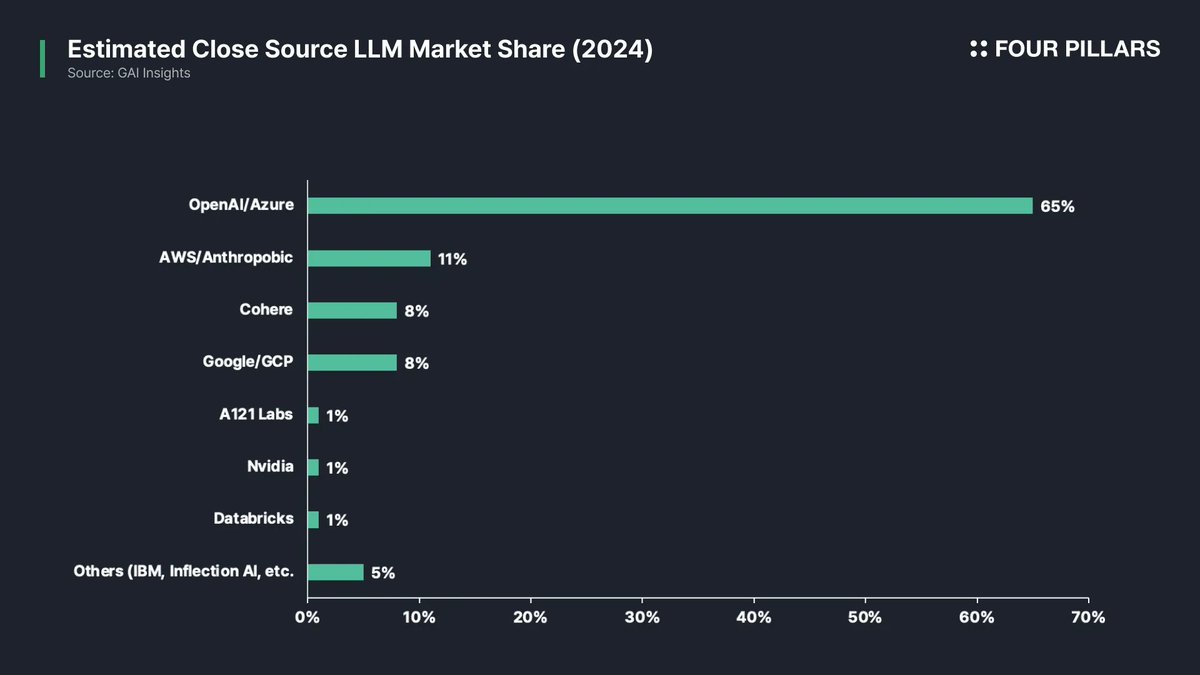AIの最大の草の根運動
AIの最大のボトルネックは、モデル設計やGPUではなく、データです。そして今、そのデータは閉じ込められ、乱されています。大手Web2プラットフォーム(Reddit、X、Googleなど)は、情報を有料の壁や厳しいTOSの背後に隠しています。データの独占が到来し、小規模企業が餓死しています。同時に、オープンなWebの品質は急速に低下しており、情報が故意に汚染され、AIが生成したフラフがコーパスを汚染しています。これはまさに完璧な嵐です:AIはデータを必要としていますが、その井戸は守られ、汚染されています。


*See full version of “AI’s Biggest Grassroots Moment” onFour Pillars’ Research Portal
1. 草の逆張りベット:スクレイパーを分散化し、パイプラインをトークン化する
入力する @getgrass_io, このスクリプトを反転させる分散型のWebスクレイピングプロトコル。何百万もの日常的なデバイス(現在はPC、近々は携帯電話)が、公共データを24時間365日スクレイピングするミニWebクローラーとして機能すると考えてください。Grassは、生のWebコンテンツを構造化されたAI用データセットに変換し、それを暗号経済を介して行います:ユーザーは、帯域幅と計算を提供することで報酬を獲得します。これは、情報のためのビットコインではなく、情報のためのクラウドソーシングWebマイニングのようなものです。
2. スウォームはすでに生きています
Grassはすでに大規模で稼働しています。世界中で300万ノード以上がネットワークに接続されており、日々驚異的な1,500 TBのデータを集めています。Grassは数え切れないほどの居住者のIPを使用することにより、通常のスクレイピング警報をトリガーせずにサイトからデータを収集することができます(あまりにも多くのクロールでIPが禁止されることはもうありません)。それは基本的に巨大な中央集権データファームを個々の「データビー」の群れで置き換えるものです - 叩くのが難しく、スケーリングしやすい。

なぜこれが重要なのか?なぜなら、これによりデータの独占が崩れるからです。数人の大手企業がデータを独占したり、不当な料金を請求したりする代わりに、どんなAIスタートアップや研究者もGrassのデータストリームにアクセスできます。RedditやTwitterのコンテンツをAIモデルに取り込むことを想像してみてください。APIアクセスを懇願したり、数百万ドルを支払ったりすることなく、Grassはそれを実現可能にします。これはAI時代の許可なしの選択肢です。データが新しい石油であるなら、Grassは誰もが掘削できる分散型オイルリグネットワークを構築しています。
3. ZKプルーフを使用してデータを検証する
品質管理は方程式のもう半分であり、Grassには賢明な答えがあります: ゼロ知識証明とオンチェーン検証。スクレイピングされたすべてのデータは、その起源と完全性を証明する暗号的証拠(ZK-SNARK)で押印され、Grass独自のブロックチェーン(この目的のために彼らが構築している主権ロールアップ)に記録されます。要するに: それぞれのWebスニペットに対して「これはXソースからY時間に取得され、改ざんされていない」と記載された領収書を受け取ります。これはデータの汚染とジャンクとの戦いにとって非常に重要です。パイプラインが検証可能な場合、疑わしいまたは破損したデータをフィルタリングしたり、少なくとも問題を追跡したりすることができます。AIが誤ってAI生成のガベージをトレーニングする可能性がある世界では、データに対する信頼性スタンプを持つことはゲームチェンジャーです。
4. ペタバイトごとのスケーリングとそれ以上
技術スタックについて話しましょう:GrassはSolanaで始まりました(速度のため)、しかし、Solanaでもここでの取引高を処理することができません。チームは、メインチェーンからの重いスループットを処理するために自己独立型のロールアップ(それを自分たちのL2ブロックチェーンと考えてください)を展開することを考えていますが、基本レイヤーで信頼をアンカリングし続けます。
彼らは現在のメジャーアップグレードをサイオンと呼んでおり、すでに貨物列車のようにヒットしています。現在、Grass は 1 日あたり 1,500 TB を超えるデータを、目標としてではなく、ライブ メトリックとして処理しています。Sion(フェーズ1とフェーズ2)は、ネットワークを強化し、ペタバイト規模のスループットを解き放ち、テキストだけでなく画像や動画も大規模にストリーミングするリアルタイムのマルチモーダルスクレイピングを可能にしました。基本的に、Grassはテキストのみのダイエットから、Webデータの食べ放題ビュッフェにレベルアップしました。テキスト(hello vision models、GPT-4など)を超えて考えるAIの人々にとって、これは大きな問題です。

5. どのように$GRASSがフライホイールを推進するか
今、Grassはこの広がるネットワークをどのようにインセンティブ化していますか? トークンエコノミクスを導入します。現在、ユーザーはノードを実行するために「Grassポイント」を稼ぎます-基本的には実物のプレースホルダーです。適切な$GRASSトークンは地平線にあり、これが暗号通貨とAI経済が出会う場所です。 トークンの有用性はすべてのシステムを結びつけます: AI企業または研究者が費やします$GRASSデータをリクエストする(APIコールごとに支払うようなものですが、分散化されています)、そしてノードオペレーターが稼ぎます$GRASSこれらのリクエストを満たすために(スクレイピングとデータの配信)。ネットワーク内の検証者は、正直な振る舞いと高品質なデータの配信を保証するためにトークンをステークする可能性があります(悪意のある行為者は処罰され、善意のある行為者は報酬を受ける可能性があります)。要するに、$GRASSデータの消費者と提供者の間のインセンティブを整えることで、車輪を滑らかにします。
6. 実際のPMFを持つ分散型インフラ
重要なのは、GrassのアプローチがAIにおけるいくつかの存在問題を緩和していることです:
- データアクセスの不平等:今日、GoogleやOpenAIだけが全体のWebをクロールできます(そして彼らさえ訴えられたりブロックされたりします)。 Grassは、少しのトークンを支払える人々にWebスケールのデータをアクセスできるようにすることで、プレイフィールドを均等にします。
- データ品質と毒入れ:オンチェーンの証明と(最終的には)コミュニティ駆動の検証により、誰かが毒性のあるデータを無断でトレーニングセットに紛れ込ませることはずっと難しくなります。Grassは、オンチェーンの指紋と一致しないコンテンツをフラグ付けしたり除外したりすることができます。時間の経過とともに、ネットワークの分散構造は、AIによって生成されたコンテンツを特定し、それがループを強化するのを防ぐのに役立つかもしれません(たとえば、単なるChatGPTの出力であるニュース記事をフィルタリングすると想像してください)。
- 検閲耐性:Grassは数千の独立ノードを介して動作するため、1つのキルスイッチで情報の流れを止めることはできません。それはストライサンド効果がブロックチェーンと出会うものです - ここでデータをブロックしようとしても、それは単に回り道します。AI開発者にとって、それはより堅牢なパイプラインを意味します。
7. 最終アルファ: ブラックボックスを構築せず、グラスルーツAIを構築してください
はっきり言って、Grassはまだ発展の初期段階にあります。ベータ版ですが、一部はまだ中央集権化されています(現在は中央のコーディネーターがいますが、後で分散化されます)、データの保存/クリーニングは現時点ではクライアント側で行われています。しかし、軌道は決まっています。ネットワークは規模が爆発的に拡大しており(この年にノード数やデータ量で過去最高に達しています)、各アップグレード(Sionなど)が完全な自己持続型プロトコルに近づけています。
そのビジョンは大胆です:Grassは分散型AIのデータレイヤーになりたいと考えています。需要に応じて誰でも高品質のトレーニングデータをソースできるオープンマーケットプレイスを想像してみてください。暗号信頼が組み込まれています。RedditやGoogleに支払われる巨額の家賃も門番もなく、自分の尾を食べてモデルが崩壊することへの心配も少なくなります。コミュニティによって所有され、暗号で保護されたAIデータファイアホースです。
In a crypto world hungry for real utility, Grass stands out as a project merging two mega-trends (AI & DePIN) with a real product in the wild. It’s meme-savvy by name but serious in execution. If it succeeds, Grass could transform the AI landscape – turning the web itself into a living, breathing data source that’s open to all. For VCs, builders, and Crypto Twitter lurkers, keep an eye on this one. It’s not often you see a new layer of internet infrastructure being built in real time, powered by a token and a dream of free-flowing information.
免責事項:
- この記事は[から転載されましたPonyo : : FP]. すべての著作権は元の著者に帰属します [Ponyo : : FP]. If there are objections to this reprint, please contact the Gate Learnチーム、そして彼らが迅速に処理します。
- 責任の免責事項:この記事で表現されている見解や意見は、著者個人のものであり、投資アドバイスを構成するものではありません。
- Gate Learnチームは、記事を他の言語に翻訳します。翻訳された記事のコピー、配布、または盗用は、特に許可されていない限り禁止されています。
関連記事

VirtualsのAIXBTとは何ですか?AIXBTについて知る必要があるすべてのこと

Virtuals Protocol: AIエージェントのトークン化

Tars AIとは何ですか?AIとWeb3統合の未来を探る

クリプトナラティブとは何ですか?2025年のトップナラティブ(更新版)

AIエージェントが暗号資産を主流にする方法
